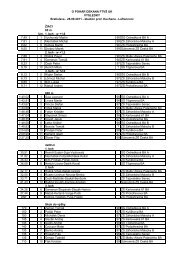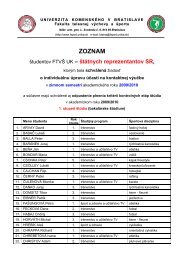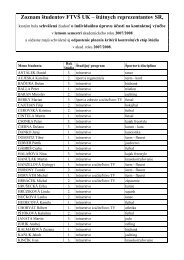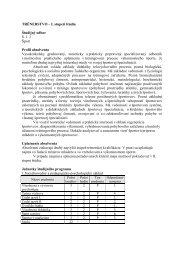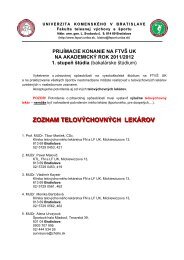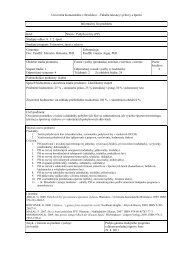acta facultatis educationis physicae universitatis comenianae
acta facultatis educationis physicae universitatis comenianae
acta facultatis educationis physicae universitatis comenianae
Create successful ePaper yourself
Turn your PDF publications into a flip-book with our unique Google optimized e-Paper software.
Analyze of sport talent selection systems<br />
13<br />
ANALYZE OF SPORT TALENT SELECTION SYSTEMS<br />
Martin Sebera 1 , Jaromír Sedláček 2<br />
1 Faculty of Sport Studies Masaryk University, Brno, Czech Republic<br />
2 Faculty of Physical Education and Sports, Comenius University in Bratislava, Slovakia<br />
Summary: In the contribution authors deal with review of some sport talent identification and<br />
selection systems which were applied in some countries that play important role in international<br />
sport movement during lest decades. There were two main systems of talent selections: USSR and<br />
GDR ways. Adjusting of any system mainly depended on quantity of countries´ population.<br />
As a most important seems factor of first talent identification (age precision), that is connected<br />
with the beginning of training in each sport. Next steps are connected with talent development<br />
and there are several phases of the process until international level can be reached. In conclusion<br />
authors suggest main principles of model sport talent selection.<br />
Key words: sport talent, talent selection, national systems, talent development<br />
Talent Identification is often regarded as the first step to become an international athlete.<br />
Common reasons for countries to blame the system of Talent Identification is to reach international<br />
performance level, gain number of medals, made successful champions.<br />
Talent detection refers to the discovery of potential performers who are currently not<br />
involved in the sport, as opposed to talent identification (TID) that refers to the process of<br />
recognizing current participants with the potential to become elite players (Williams, Reilly,<br />
2000). This process of talent detection and talent identification has to be followed concomitantly<br />
with the talent development program in order to direct those potential performers<br />
towards the sports to which they are most suited (Woodman, 1994).<br />
Thorough analysis of talent identification approaches from around the world has brought<br />
out plenty of special features either to follow or to dismiss. Ultimately, besides other important<br />
factors determining the TID approaches there was always one which kept overweighing all<br />
others by drastically changing the process, and by giving origin to the two quite opposite<br />
approaches to talent identification: Availability or absence of human resources talent<br />
selection.<br />
In other words, do we have statistically sufficient number of subjects to brush through<br />
in order to identify substantial number of talented children for the needs of the reserve and<br />
top performance sports? Accordingly, the choice of Talent Identification system in the first<br />
approximation could be as summarized in Table 1.<br />
Acta Facultatis Educationis Physicae Universitatis Comenianae LII/I





